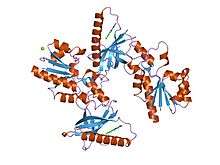Prokaryotic riboflavin biosynthesis protein
| FAD synthetase | |||||||||
|---|---|---|---|---|---|---|---|---|---|
 crystal structure of flavin binding to fad synthetase from thermotoga maritina | |||||||||
| Identifiers | |||||||||
| Symbol | FAD_syn | ||||||||
| Pfam | PF06574 | ||||||||
| Pfam clan | CL0119 | ||||||||
| InterPro | IPR015864 | ||||||||
| SCOP | 1n05 | ||||||||
| SUPERFAMILY | 1n05 | ||||||||
| |||||||||
In molecular biology, the prokaryotic riboflavin biosynthesis protein is a bifunctional enzyme found in bacteria.
Riboflavin is converted into catalytically active cofactors (FAD and FMN) by the actions of riboflavin kinase EC 2.7.1.26, which converts it into FMN, and FAD synthetase EC 2.7.7.2, which adenylates FMN to FAD. Eukaryotes usually have two separate enzymes, while most prokaryotes have a single bifunctional protein that can carry out both catalyses, although exceptions occur in both cases. While eukaryotic monofunctional riboflavin kinase is orthologous to the bifunctional prokaryotic enzyme, the monofunctional FAD synthetase differs from its prokaryotic counterpart, and is instead related to the PAPS-reductase family.[1][2] The bacterial FAD synthetase that is part of the bifunctional enzyme has remote similarity to nucleotidyl transferases and, hence, it may be involved in the adenylylation reaction of FAD synthetases.[3]
References
- ↑ Karthikeyan S, Zhou Q, Osterman AL, Zhang H (November 2003). "Ligand binding-induced conformational changes in riboflavin kinase: structural basis for the ordered mechanism". Biochemistry. 42 (43): 12532–8. doi:10.1021/bi035450t. PMID 14580199.
- ↑ Galluccio M, Brizio C, Torchetti EM, Ferranti P, Gianazza E, Indiveri C, Barile M (March 2007). "Over-expression in Escherichia coli, purification and characterization of isoform 2 of human FAD synthetase". Protein Expr. Purif. 52 (1): 175–81. doi:10.1016/j.pep.2006.09.002. PMID 17049878.
- ↑ Krupa A, Sandhya K, Srinivasan N, Jonnalagadda S (January 2003). "A conserved domain in prokaryotic bifunctional FAD synthetases can potentially catalyze nucleotide transfer". Trends Biochem. Sci. 28 (1): 9–12. doi:10.1016/S0968-0004(02)00009-9. PMID 12517446.
This article incorporates text from the public domain Pfam and InterPro IPR015864